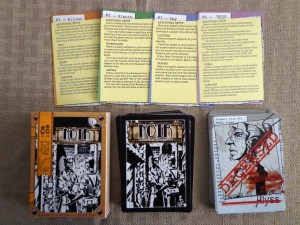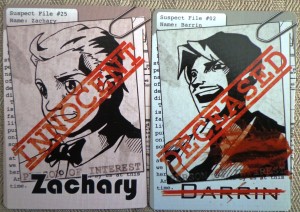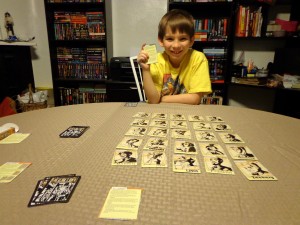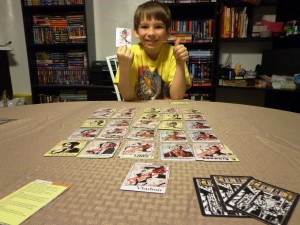One of the first “detective” board games I remember playing as a kid was “Clue: The Great Museum Caper”, which involved one player taking on the role of a thief attempting to steal paintings from under the noses of the other players. “Mr. Jack in New York” is a more recent game I’ve played that tasks one player (the detective) in finding and catching the other (Mr. Jack) through a series of logical deductions. “NOIR” feels like a combination of both games, however in this instance, both players have hidden identities and will be attempting to thwart the other in different ways. Before we get started, I’d like to thank Brad Talton from Level 99 Games for sending me a free review copy. While the game is still about a week away from being released to the general public, the pictures you’ll see in this article represent the final components.
Components
Suspect Deck – This twenty-five card deck contains a picture of a character on both sides, one representing the “live” side and one representing the “deceased” side.
Evidence Deck – This twenty-five card deck contains the same characters as in the suspect deck, where one side shows an “innocent side” over top the character’s picture while the other is simply a card back.
Reference Cards – These assist in reminding players as to what their abilities are.
Editor’s Note: The game’s manual lists four different variants. For review purposes, I’ll be touching on the first variant called “Killer vs. Inspector.” This is a two player variant that takes roughly fifteen to thirty minutes to play. I included a link to the rulebook later on in this review, for your reference.
Setup & Gameplay
The suspect deck is shuffled and laid out in a five by five grid with the deceased side face down. The evidence deck is shuffled and placed off to the side. Players will then decide which will be the killer and which will be the inspector. The killer draws a card from the evidence deck, which remains hidden from the inspector as it serves as the killer’s hidden identity. The inspector draws four cards for his or her hand and play starts with the killer.
For the killer’s first turn, they must kill one of the characters adjacent to them, whether it be directly or diagonally. The character that was killed is then flipped to the deceased side. This gives the inspector a clue as to who the killer is and must proceed from there. On the inspector’s first turn, they pick one of the four cards from their hand and puts it face down in front of them. This card is now the inspector’s secret identity.
From there, the killer and inspector take turns performing actions, which consist of the following:
Kill (Killer) – The killer chooses a card adjacent to them (like on their first turn) and flips it to the deceased side. If all of the characters in a row or column are killed, that row or column is removed from the game. If the killer kills sixteen characters or the inspector, they win the game.
Disguise (Killer) – The killer can draw from the innocent deck and assume the role of that character, assuming that character is alive on the board. Once the innocent deck runs out, this action is no longer possible.
Shift (Both) – The killer or inspector chooses any row or column and moves the cards over/down a space. The card that falls off the five by five grid is placed in the empty space at the beginning of the row / column.
Arrest (Inspector) – The inspector chooses a character adjacent to them (similar to the kill action) and asks the killer if he is the person in question. If they are, the inspector wins the game. If not, play continues.
Exonerate (Inspector) – The inspector draws a card from the innocent deck and puts it on top of the character in play, identifying that person as innocent. Once the innocent deck runs out, this action is no longer possible.
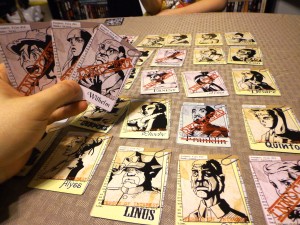
Vinnie, the killer, just knocked off Franklin. Since three of the eight around him are innocent and I hold Deidre in my hand, I’m able to conclude that he is either Phoebe, Linus, Simon, or Quinton.
Play continues until the killer has killed sixteen characters / the inspector or until the inspector arrests the killer. As I mentioned above, this is but one of the four different variants listed in the manual. You can check out the other variants in the master rulebook, located here:
http://www.lvl99games.com/wp-content/uploads/2012/09/Master-Rulebook.pdf
The Review
I like the fact that there are four different variants listed in the manual, which add a lot of replay value to the base game. There’s also a neat reference card for each variant, something I appreciate. Since each of the variants have different player requirements and average play times, players will be able to choose the variant that is best suited for them at the time. The “Killer vs. Inspector” and “Hitman vs. Sleuth”, for example, would be an excellent twenty minute game to play with one of the kids after homework and before bed. “Spy Tag”, on the other hand, might serve as a good filler for adults in between longer tabletop sessions.
There’s a lot of strategy and thinking required with this game, so if you’re looking for a quick mindless fix, this game may not be for you. On the other hand, those who enjoy deduction and logic puzzles will get a lot of this particular card game. Keeping a player’s identity secret is important on sides of the fence, so the game will remain tense throughout regardless if you are one party or the other.
The kids seemed to enjoy the game, mainly because they got a chance to flex their deduction muscles a bit in an attempt to outsmart dad. Vinnie (11) had a difficult time remembering and deducing which characters were likely to be the secret identity of his opponent, but with some coaching he pulled through and kept pace rather well. I, on the other hand, had him narrowed down to about two or three people most of the time. While this proves that there is an age barrier in terms of skill level, the game still remained to be fun regardless so as long as the mood and atmosphere were kept “light.”
Overall, “NOIR” is a pretty fun game, one that I’m glad I was able to add to my collection. I enjoy a good deduction game, especially if it involves secret identities and logic. Both the box and the cards were top-notch in terms of quality, and I was extremely pleased by the art displayed on them. Currently, the game is going for $12.00 (as of 1/4/13), which I think is a fair price overall. If you’re into quick games of deduction and cunning, I’d recommend picking this up.
Final Verdict: 8/10
—
You can learn more about and purchase “NOIR” by visiting the official website, here:
http://www.lvl99games.com/store/index.php?main_page=product_info&cPath=1&products_id=17
—

